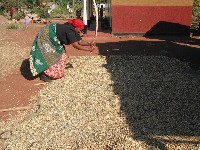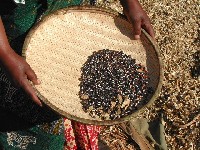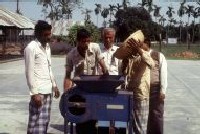Labour-saving technologies and practices: manual and motorised cleaning of grains and pulses
This practice describes methods to clean and separate the trash of threshing, providing features of cleaning grains and pulses, by manual and motorised ways. The advantages and disadvantages of this practice are additionally highlighted.
Description
- Traditional threshing methods often leave a lot of rubbish mixed with the grains and pulses.
- Separating the rubbish can be very labour-intensive.
- Traditional cleaning is carried out by winnowing or sieving and sometimes a combination of the two.
1. Traditional cleaning methods
1.1 Winnowing
- In windy areas the threshed crop is tossed up into the air, using forks, spades or baskets.
- The grain and pulses fall vertically while the less dense chaff and straw are blown to one side.
1.2 Sieving
- Further, cleaning is carried out using sieves, made of open-weave baskets or a wire mesh, to remove soil, stones and any metal objects (such as nails and screws).
- The removal of the latter is important, particularly when mechanised milling is to be undertaken, as they can damage the milling screens.
2. Features of cleaning grains and pulses
- Simple wooden or steel enclosed fan mills using sieves and screens makes more efficient use of manual power, operated either by hand or pedal power.
- Output ranges from around 150 to 300 kg per hour.
- Motorized threshers often include the winnowing and cleaning process.
- Specialized motorized cleaners range from the simple to the complex; some also grade the seed at the same time.
- Many are mobile and can be used by contractors.
- Quoted outputs range from one to four tonne per hour for motors of around 3 kW.
Figure 1. Woman threshing

©FAO/TECA
Figure 2. Hand sieving of grain

©FAO/TECA
Figure 3. Seed cleaning

©FAO/TECA
3. Advantages
3.1 Labour saving
- Reduces labour bottlenecks at peak periods, particularly motorised equipment.
3.2 Livelihood resilience strengthening
- Clean, undamaged and pest and disease free produce at the correct moisture content fetch higher prices when sold or assists with preparing the seed for storage or planting.
- Grading of grain or pulses is required for sale and for selecting appropriate seed plates for mechanized planting.
3.3 Livelihood diversification
- Income generating opportunities if motorised equipment operated by community group or contractor.
3.4 Equipment
- Manually operated equipment is robust and relatively easy to fabricate, maintain and repair.
3.5 Skills
- Manually operated equipment is simple to operate.
4. Disadvantages
4.1 Labour
- The modest increase in work rates with manually operated equipment may not justify the cost of equipment.
4.2 Equipment
- Some cleaning equipment may be required for only a short period during the year and lies idle for most of the year.
4.3 Cost and risk
- Relatively high cost for private ownership and hence relatively high financial risk.
4.4 Skills
- Motorized equipment requires some specialist skills in use and maintenance of machine.
4.5 Risk
- May fail if hire services are introduced into an area where there is insufficient demand to pay for contractual and community-owned services.
4.6 Infrastructure
- Motorized equipment requires adequate supporting infrastructure.
5. Related/associated technologies
- Labour-saving technologies and practices: manual carrying, wheelbarrows, hand carts and bicycles: ID 7312.
- Labour-saving technologies and practices: manual and motorised threshers: ID 7313.
- Labour-saving technologies and practices: manual crop processing: ID 7317.
- Labour-saving technologies and practices: solar drying equipment: ID 7319.
- Labour-saving technologies and practices: improved use of hoes for land preparation, planting and weeding: ID 7296.
This technology is also available in Portuguese: ID 2310.
6. Objectives fulfilled by the project
6.1 Labour-saving technology (LST)
The practice is labour-saving, strengthens livelihood resilience, diversifies income, and has easy equipment to use requiring no additional skills.
Autor: Rural Infrastructure and Agro-industries Division (Agricultural Machinery and Infrastructure) AGS in FAO
Organización: The Food and Agriculture Organization of the United Nations FAO TECA
Año: 2020
Tipo: Prácticas
Texto completo disponible en: https://www.fao.org/teca/en/technologies/7310
Idioma utilizado para los contenidos: English
